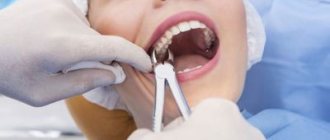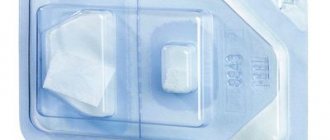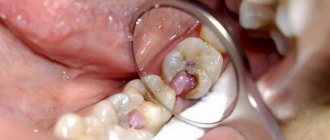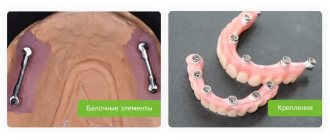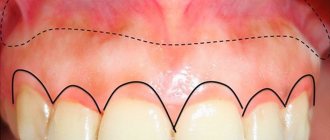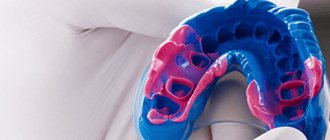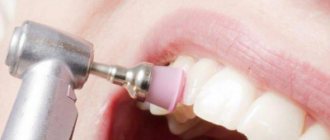Dental restoration solves not only functional problems, replacing lost teeth with artificial ones. Orthopedists attach no less importance to the aesthetic component of prosthetics. Functionality and aesthetics are combined by the use of artificial gums.
Most often, this design is used in the manufacture of removable dentures. The crowns are fixed to the base, creating a complete imitation of the gums and teeth in it. The materials for such products are polymers: acrylic, nylon, AcryFree. The last two are hypoallergenic, but acrylic can cause an allergic reaction. Teeth on artificial gums transfer part of the load to the base, but this distribution is uneven. Adequate distribution is only possible with implant prosthetics.
Functions of artificial gum in implant-supported dentures
In removable dentures, artificial gum is a mandatory element. When the structures are simply fixed on the gums, the artificial gum provides additional fixation because it tightly grips the alveolar ridge.
In the case when the prosthesis is installed on implants, fastening elements are located inside it, just under the gum, on the back side of the dental crowns. Therefore, artificial gum helps to hide them, allowing you to give the dentition a sick aesthetic.
In some cases, doctors insist on adding artificial gum even to permanent dentures . Naturally, this surprises patients. But the gums also play a role, especially with extensive tooth loss or complete edentia. Dental crowns are used to fill the dentition, but artificial gums are used to fill the height of the bite.
This option is applicable for situations where, as a result of a long absence of teeth, your bone tissue has noticeably decreased in volume - the level of the gums, naturally, has fallen. And in order for the dentition to be even, you will have to either build up the bone to the required volume, or choose basal implants that are fixed in the existing bone volume, but then the prosthesis will have a small part of the gum. In addition, if the cause of tooth loss is diseases such as periodontitis or periodontitis, in which the tissues atrophy unevenly, with prosthetics without artificial gums it would be necessary to make crowns that differ significantly in height, which would be completely unsatisfactory from an aesthetic point of view. If bone atrophy is not significant, then the prosthesis is made without artificial gum.
General overview
One of the tasks of prosthetics is to create a structure that does not differ in appearance from natural tissues and tooth enamel. This also applies to the mucous membrane of the area adjacent to the surgical site. Artificial gum performs both aesthetic and supporting functions, allowing the jaw to return an attractive appearance even in situations where the patient has been diagnosed with extensive edentia.
Quite often there are situations when the consequence of poor-quality dental treatment is the development of atrophic processes that affect not only soft tissues, but also the spongy structure in those areas where voids are localized. The use of a prosthetic element of this category is distinguished not only by the loyalty of the method used in terms of the degree of intervention in the body, but also by the minimal time and financial costs that the patient is forced to face.
Classical implantation with bone tissue augmentation
To install implants of a standard classic type, a sufficient amount of bone tissue is required. In this case, you receive a denture without artificial gums, consisting solely of dental crowns. But you will lose in the following:
- the cost of treatment will increase: since the augmentation operation costs some money, besides, classical implantation is almost twice as expensive as the basal method,
- the treatment period will increase: at least three months are needed to restore the bone after augmentation and the same amount more for the complete engraftment of the implants, only after this it will be possible to install a permanent prosthesis
Plastic surgery of soft tissues in the oral cavity: features of the procedure
Before the operation, in our clinic, we first conduct a consultation with the dentist and carefully plan the upcoming procedure. Treatment tactics are always agreed upon with the chief physician. If there is a deficiency of soft tissues, they are built up and their volume is increased using tissue from special donor areas in the oral cavity. And if there is an excess of periodontal tissue, the excess part is removed.
The operation is performed by a periodontist surgeon. He uses local or general anesthesia. It depends on the patient's wishes. During the operation, the edge of the gum is cut closer to the tooth or implant, the surface is cleaned of plaque, food debris, and dental deposits, and work begins with the soft tissue itself.
When performing a local operation, soft tissues are taken from the donor area (on the palate or in the area of the tubercle of the upper jaw) in the oral cavity, their surface is cleaned in a certain way to obtain a true donor graft and applied to the required exposed area.
Expert opinion
Roman Borisovich Alekperov
orthopedic dentist
Experience: 24 years
Although artificial gum helps distribute the load on the jawbone, this distribution is not uniform. This means that over time, atrophic dentures will inevitably develop under the removable denture, the bone will sag, the denture will become uncomfortable, no longer fit, or may even break during chewing. How to prevent the development of bone deficiency? Only with the help of implantation! If you decide to install implants after the tissue has begun to “go away,” take advantage of the possibilities of basal implantation.
What is a metal-ceramic crown?
This is an anatomically accurate imitation of the patient’s specific tooth, also made taking into account the individual characteristics of his bite. Externally, it does not differ from a natural tooth. The price of a metal-ceramic crown with an inlay is quite affordable, for example, compared to zirconium crowns.
Metal ceramics are well suited for restoring chewing teeth, since the base of the crown is durable metal. For manufacturing, hypoallergenic alloys are used that do not oxidize under the influence of saliva and do not cause irritation of the mucous membrane. The only contraindication may be individual intolerance to the metal.
In a dental laboratory, the metal base is covered with several layers of ceramic mass, the shade of which is previously selected to match the patient’s teeth. While metal ceramics may not look entirely natural in the smile area, for the chewing area it is an excellent option that is suitable for most people. For the price, the combination of a metal-ceramic crown plus an inlay will also suit OneDent patients.
ROOTT implantation with immediate loading WITHOUT bone tissue augmentation
During ROOTT express implantation, specially designed implants are used, which eliminate the need for bone augmentation. They are fixed in the deepest layer of bone tissue (basal section), which is not subject to atrophy even after several years of missing teeth. As a result, the implants are securely attached and can withstand maximum loads for many decades. But you get a denture with a small piece of artificial gum. But you save in the following:
- the treatment period is reduced: the implants have a solid structure (the tip after installation remains above the gum level) and excellent primary stability, so immediate loading is allowed already 2-3 days after surgery. And due to the usual pressure, bone cells grow as quickly as possible around the installed implant.
- the cost of treatment is reduced: since augmentation surgery is not required, the number of treatment stages is reduced. Due to the reduction in treatment time, the cost is also reduced - when restoring completely lost teeth in two jaws, it is almost two times lower than the classical protocol,
Let us note that today artificial gums are made from modern materials and are matched in shade to the color of natural gums. As a result, the prosthesis is very thin, does not cause discomfort and is completely invisible to others.
Recovery period
Healing time
The superficial layers of soft tissue heal within 10-14 days, then the sutures are removed. At this stage we can already talk about the primary effectiveness of the operation.
Full recovery will take from three months to six months - during this time the molecular connections in the gums and blood supply are restored. At this stage, the final result is assessed.
Accelerated rehabilitation
After perioplasty, swelling, redness of tissues, and pain are observed. These symptoms are within normal limits; within three days the symptoms decrease. For those who want to quickly get rid of unpleasant consequences, our Center has developed a unique complex of accelerated rehabilitation:
Recommendations
To ensure that the transplanted tissue heals well, after the operation, use antiseptic preparations to irrigate the wound, and take prescribed antibacterial drugs. You will receive all the necessary medications after the operation for free ; you will not have to run to pharmacies.
The postoperative kit contains painkillers, antibacterial and antihistamines
To improve healing, follow the doctor's recommendations; they are written in the brochure that you will find in the package with the medicines.
Basic rules for the postoperative period:
- Use a protective mouthguard to prevent damage to the surgical wound
- Do not eat food for the first 5-10 hours, you can drink water after a couple of hours
- When eating, stick to your diet - exclude sour, spicy, salty, hard foods.
- Don't smoke for at least 3 days
- Carry out thorough hygiene - cleaning 2-3 times a day, it is not recommended to touch the surgical site with a brush
- Limit physical activity
If any suspicious issues arise - persistent pain, prolonged bleeding, increasing swelling, instability and mobility of the implant - consult a doctor immediately. Your doctor's phone number is indicated on the recommendation card. The patient support service operates around the clock 24/7 without weekends and holidays.
Advantages of our center for modern dentistry:
Why you should contact Uniklinik Center for Modern Medicine LLC in Moscow:
- Our clinic employs doctors of medical sciences, professors, and dentists who regularly take advanced training courses in Russia and European countries.
- For 15 years we have been providing dental services of very high quality.
- The clinic has a computed tomograph, a cephalostat, a digital modeling system, and a dental microscope.
- We use modern treatment methods - invasive bone surgery, immediate implantation, tooth extraction, periodontal surgery, all types of prosthetics and orthodontic treatment.
Thanks to such a thorough and comprehensive approach to each patient, and coordinated work in a team of highly qualified doctors, for many years we have been obtaining very highly aesthetic and functional work, which our patients enjoy with great joy.
